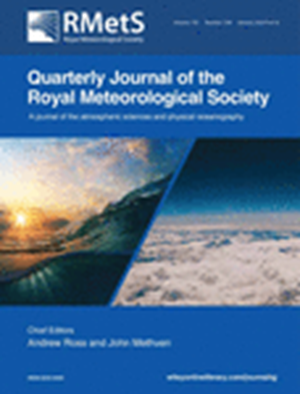印度夏季季风五月在印度东北部 "开始 "的动力学特征
IF 3
3区 地球科学
Q2 METEOROLOGY & ATMOSPHERIC SCIENCES
引用次数: 0
摘要
与印度中部相比,印度东北部的雨季持续时间较长,因此印度东北部夏季季风的正式开始时间传统上是 6 月 5 日左右,5 月份的降雨被归类为 "季风前期"。然而,我们的研究表明,东北印度地区 5 月份的降雨发生在由持续性同步尺度系统驱动的活跃/爆发期,在此期间形成了重要的季风热源。通过客观分析,我们确定东北地区气候学上的 "开始 "实际上发生在 5 月 18 日左右,并在 10 月 14 日左右消退,导致雨季延长约 150 天。在热带辐合带仍然靠近赤道的情况下,5 月份雨季开始的谜团通过确定 5 月份的有利气候得到了解决。这种气候的特点是该地区上空的低层气旋涡度受到大西洋尼诺现象(厄尔尼诺现象)年际增强(减弱)的影响。五月,外热带瞬态罗斯比波带来的潜在涡度将低层气旋涡度显著放大 3-4 倍,成为东北地区季风开始的催化剂。此外,来自孟加拉湾的北向水汽输送增强了 5-6 倍,维持了季风开始后的热源。雅鲁藏布江河谷周围的马蹄形地形促进了低层气旋风的抬升,使五月季风的形成成为可能。同时,蒸发蒸腾作用也增加了当地的含水量。我们的研究结果挑战了传统观念,证明东北印度夏季季风降雨的一部分与热带辐合带没有直接关系。这对南亚季风的基本定义提出了挑战,并要求重新评估印度季风季节仅限于东北印度洋 6-9 月的普遍看法。本文章由计算机程序翻译,如有差异,请以英文原文为准。
Dynamics of May ‘onset’ of Indian summer monsoon over Northeast India
Acknowledging the prolonged duration of the rainy season in Northeast India (NEI) compared to Central India, the official onset of the Indian summer monsoon over NEI is traditionally marked around 5 June, with May rainfall categorized as ‘pre‐monsoon’. However, our study reveals that May rainfall in NEI occurs in active/break spells driven by persistent synoptic‐scale systems, contributing to a significant monsoon heat source during this period. Through an objective analysis, we determine that the climatological ‘onset’ in NEI actually occurs around 18 May, with withdrawal around 14 October, resulting in an extended rainy season of approximately 150 days. The enigma of the May onset, while the Intertropical Convergence Zone remains proximate to the equator, is addressed by identifying a conducive climate in May. This climate is characterized by low‐level cyclonic vorticity over the region, influenced by the interannual strengthening (weakening) by the Atlantic Niño (El Niño). The introduction of potential vorticity from extratropical transient Rossby waves in May significantly amplifies low‐level cyclonic vorticity by 3–4 times, acting as a catalyst for the monsoon onset in NEI. Furthermore, a 5–6 times intensification of northward moisture transport from the Bay of Bengal sustains the monsoon heat source post onset. The May onset is made feasible by the uplifting of low‐level cyclonic winds, facilitated by the horseshoe‐shaped orography around the Brahmaputra valley. This process is complemented by an increased local moisture content resulting from evapotranspiration. Our findings challenge conventional notions by demonstrating that a component of Indian summer monsoon rainfall in NEI is not directly related to the Intertropical Convergence Zone. This challenges the fundamental definition of the South Asian Monsoon and calls for a reassessment of the prevalent belief that the Indian monsoon season is confined to June–September in NEI.
求助全文
通过发布文献求助,成功后即可免费获取论文全文。
去求助
来源期刊
CiteScore
16.80
自引率
4.50%
发文量
163
审稿时长
3-8 weeks
期刊介绍:
The Quarterly Journal of the Royal Meteorological Society is a journal published by the Royal Meteorological Society. It aims to communicate and document new research in the atmospheric sciences and related fields. The journal is considered one of the leading publications in meteorology worldwide. It accepts articles, comprehensive review articles, and comments on published papers. It is published eight times a year, with additional special issues.
The Quarterly Journal has a wide readership of scientists in the atmospheric and related fields. It is indexed and abstracted in various databases, including Advanced Polymers Abstracts, Agricultural Engineering Abstracts, CAB Abstracts, CABDirect, COMPENDEX, CSA Civil Engineering Abstracts, Earthquake Engineering Abstracts, Engineered Materials Abstracts, Science Citation Index, SCOPUS, Web of Science, and more.

 求助内容:
求助内容: 应助结果提醒方式:
应助结果提醒方式:


